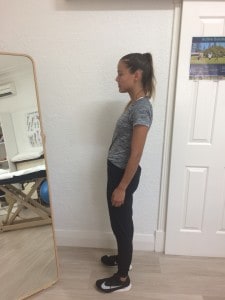Hip and groin pain can be a constant low grade ache often with a sharp catching pain on movement in the front of your hip. Usually it will just slowly creep up with the pain on and off over a few months starting for no apparent reason. Sometimes it can be due to trauma (car accident/fall off horse) but this is not common.

The pelvis is designed to best absorb impact from the leg into the back of the joint where the cartilage is thickest.
Hip and groin pain is caused by increased loading into the front of the joint.
This disruption in force transfer can be caused by a number of reasons:

- Poor standing posture that causes the axis of weight to push the hip bone forwards and loading the front of the joint.


- Repetitive movement – that overloads the front muscles like repeated kicking ball of the ground during training.

- Poor strength in bum (gluteal) muscles – often muscles feel tight, but to stretch the muscles you need to rotate the hip, which will aggravate the pain. Muscles feel tight usually because they are weak.
- Pelvic Floor Dysfunction – internal pelvic floor muscles have cross fibres with the hip joint. Pelvic floor muscles that cannot relax or are weak (after childbirth) can alter the movement of the hip.
- Lumbar or Pelvic problems – when the neighbours of the hip are weak, stiff or cannot move properly then there is increased pressure on the hip.
- High arched feet – a high arch causes a very rigid and stiff foot that rotates the hip to cause anterior loading. Also high arches cause increased impact into the leg which increases the forces through the leg into the hip.

- Shape of bones – diagnosed by XR and MRI, indicated by ‘clicky hips’ at birth and often there is a family history of ‘stiff hips’. Hip preservation surgery can be performed but this is a major operation that realigns the joint and is only considered after an attempt at a structured physiotherapy rehabilitation program.
In Summary
Most hip and groin pain can be controlled with commitment to a structured physiotherapy rehabilitation program.
It doesn’t matter what structure is affected causing pain, it is more important to determine why the pain is occurring.
If there is only an isolated acetabular tear – surgery is usually not indicated as there are very poor outcomes. If there is arthritis already present and the labral tear is repaired – wear and tear tends to be accelerated which leads to a total hip replacement (See Blog article – Do You Have Arthritic Hips? Why Do You Need to Consider an Anterior Hip Replacement?) sooner rather than later.
If within 3 months of Physiotherapy there is not significant improvement, we would consider a referral to an orthopaedic surgeon and imaging for further exploration. In any case, the strength gained with Physiotherapy Exercises pays dividends in the long run by improving hip biomechanics and hence the recovery from surgery is a faster, smoother process.









